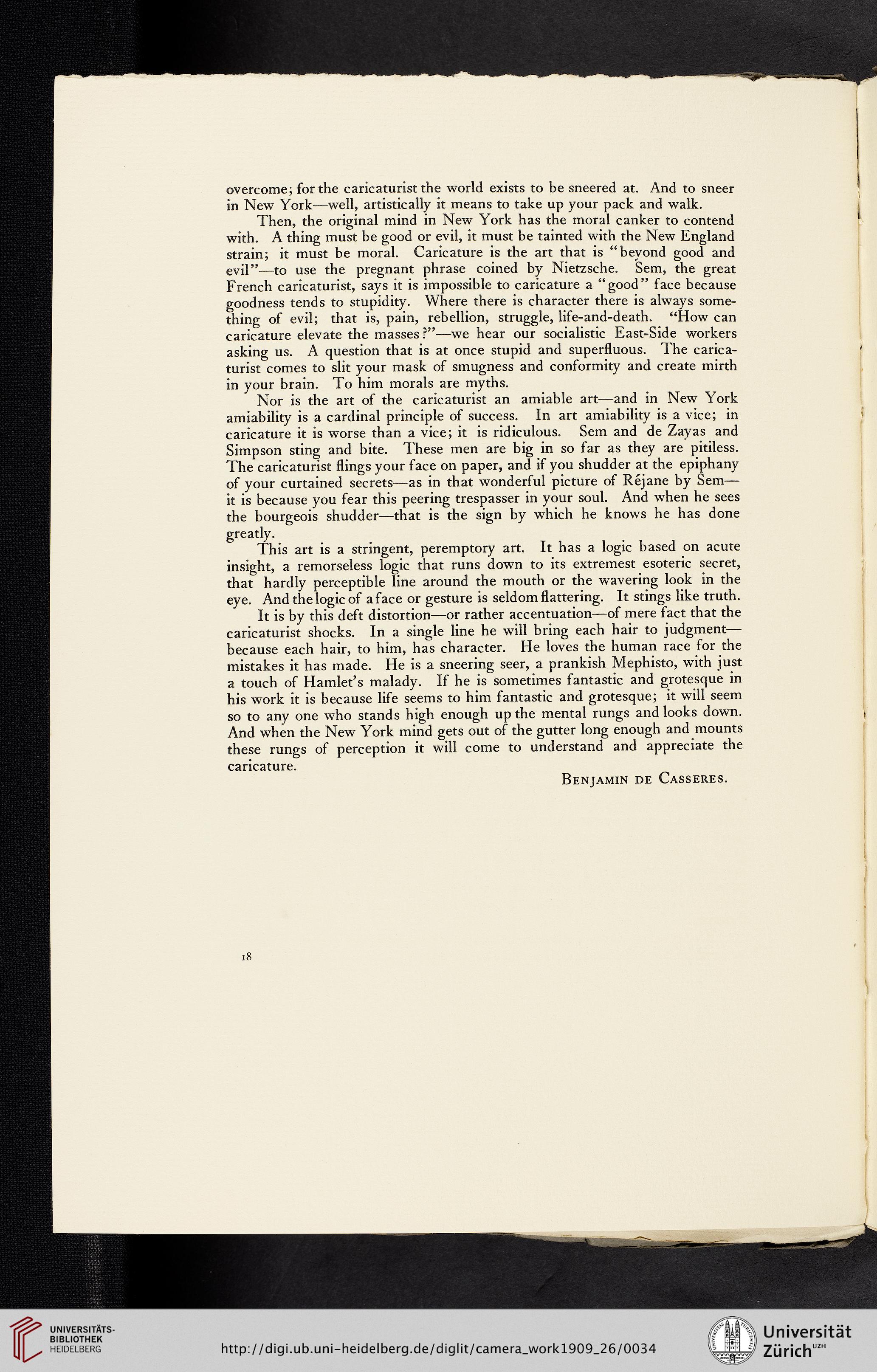Für diese Seite ist auch eine manuell angefertigte Transkription bzw. Edition verfügbar. Bitte wechseln Sie dafür zum Reiter "Transkription" oder "Edition".
overcome; for the caricaturist the world exists to be sneered at. And to sneer
in New York—well, artistically it means to take up your pack and walk.
Then, the original mind in New York has the moral canker to contend
with. A thing must be good or evil, it must be tainted with the New England
strain; it must be moral. Caricature is the art that is “beyond good and
evil”—to use the pregnant phrase coined by Nietzsche. Sem, the great
French caricaturist, says it is impossible to caricature a “good” face because
goodness tends to stupidity. Where there is character there is always some-
thing of evil; that is, pain, rebellion, struggle, life-and-death. “How can
caricature elevate the masses ?”—we hear our socialistic East-Side workers
asking us. A question that is at once stupid and superfluous. The carica-
turist comes to slit your mask of smugness and conformity and create mirth
in your brain. To him morals are myths.
Nor is the art of the caricaturist an amiable art—and in New York
amiability is a cardinal principle of success. In art amiability is a vice; in
caricature it is worse than a vice; it is ridiculous. Sem and de Zayas and
Simpson sting and bite. These men are big in so far as they are pitiless.
The caricaturist flings your face on paper, and if you shudder at the epiphany
of your curtained secrets—as in that wonderful picture of Rejane by Sem—
it is because you fear this peering trespasser in your soul. And when he sees
the bourgeois shudder—that is the sign by which he knows he has done
greatly.
This art is a stringent, peremptory art. It has a logic based on acute
insight, a remorseless logic that runs down to its extremest esoteric secret,
that hardly perceptible line around the mouth or the wavering look in the
eye. And the logic of aface or gesture is seldom flattering. It stings like truth.
It is by this deft distortion—or rather accentuation—of mere fact that the
caricaturist shocks. In a single line he will bring each hair to judgment—
because each hair, to him, has character. He loves the human race for the
mistakes it has made. He is a sneering seer, a prankish Mephisto, with just
a touch of Hamlet’s malady. If he is sometimes fantastic and grotesque in
his work it is because life seems to him fantastic and grotesque; it will seem
so to any one who stands high enough up the mental rungs and looks down.
And when the New York mind gets out of the gutter long enough and mounts
these rungs of perception it will come to understand and appreciate the
caricature.
Benjamin de Casseres.
18
in New York—well, artistically it means to take up your pack and walk.
Then, the original mind in New York has the moral canker to contend
with. A thing must be good or evil, it must be tainted with the New England
strain; it must be moral. Caricature is the art that is “beyond good and
evil”—to use the pregnant phrase coined by Nietzsche. Sem, the great
French caricaturist, says it is impossible to caricature a “good” face because
goodness tends to stupidity. Where there is character there is always some-
thing of evil; that is, pain, rebellion, struggle, life-and-death. “How can
caricature elevate the masses ?”—we hear our socialistic East-Side workers
asking us. A question that is at once stupid and superfluous. The carica-
turist comes to slit your mask of smugness and conformity and create mirth
in your brain. To him morals are myths.
Nor is the art of the caricaturist an amiable art—and in New York
amiability is a cardinal principle of success. In art amiability is a vice; in
caricature it is worse than a vice; it is ridiculous. Sem and de Zayas and
Simpson sting and bite. These men are big in so far as they are pitiless.
The caricaturist flings your face on paper, and if you shudder at the epiphany
of your curtained secrets—as in that wonderful picture of Rejane by Sem—
it is because you fear this peering trespasser in your soul. And when he sees
the bourgeois shudder—that is the sign by which he knows he has done
greatly.
This art is a stringent, peremptory art. It has a logic based on acute
insight, a remorseless logic that runs down to its extremest esoteric secret,
that hardly perceptible line around the mouth or the wavering look in the
eye. And the logic of aface or gesture is seldom flattering. It stings like truth.
It is by this deft distortion—or rather accentuation—of mere fact that the
caricaturist shocks. In a single line he will bring each hair to judgment—
because each hair, to him, has character. He loves the human race for the
mistakes it has made. He is a sneering seer, a prankish Mephisto, with just
a touch of Hamlet’s malady. If he is sometimes fantastic and grotesque in
his work it is because life seems to him fantastic and grotesque; it will seem
so to any one who stands high enough up the mental rungs and looks down.
And when the New York mind gets out of the gutter long enough and mounts
these rungs of perception it will come to understand and appreciate the
caricature.
Benjamin de Casseres.
18


